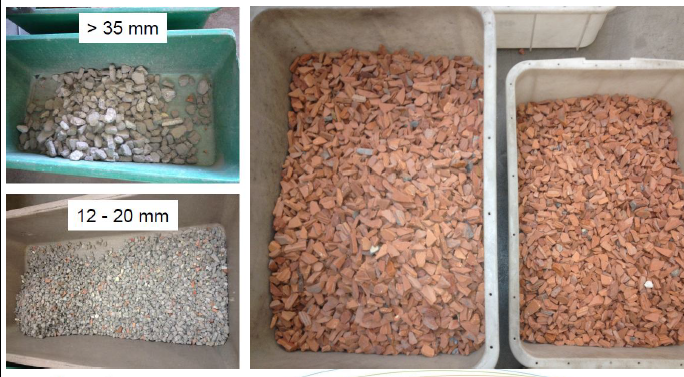Advanced sorting techniques for construction and demolition waste
The combination of near infrared detector, electromagnetic sensor and visible colour camera techniques allows to sort construction and demolition (C&D) waste with a level of purity that enables their recycling into high grade products.

The challenge
The EC Waste Directive 2008/98 targets a more sustainable construction industry by 2020, recovering a 70% (by weight) of its non-hazardous construction and demolition waste. Today, traditional waste sorting systems do not guarantee a sufficient quality of the recycled aggregates to allow for their use in high grade applications such as concrete manufacturing. The quality requirements include in particular a low content of gypsum and of organic matter. More rigorous cleaning and separating techniques are needed to reach the required levels of purity.
The innovation
The IRCOW project elaborated an upgraded sorting process allowing to sort C&D waste according to demanding criteria with regard to purity, size and colour, thus paving the way to their upcycling into high grade products.
The R&D centers VITO in the Netherlands and TECNALIA in Spain collaborated with TITECH, a company specialising in automatic sorting processes, and which put at disposal its test facility in Germany. Samples of C&D waste were collected from different sources in several European countries. The advanced sorting processes tested on the collected samples involved the combination of three online-sensing technologies:
Near Infrared (NIR) for the sorting of gypsum, cellular concrete and organic matter such as plastic and wood,Electromagnetic for the removal of metals,Colour camera to sort grey concrete, red bricks and tiles, as well as unwanted contaminants of different colour than the two targeted ones.The tests showed that the electromagnetic sensors were efficient in removing all kinds of metals and could also be combined into one single sorting unit with NIR sensors. The colour camera sorting system proved a successful separation of red ceramic aggregates and concrete (grey) recycled aggregates, leading to a high grade concrete fraction perfectly suitable for use in new concrete products (purity up to 97%).
Output of the colour sorting process (courtesy IRCOW project)
The NIR technology performed well at sorting gypsum, bright cellular concrete, organic matter and metals out. It was also very effective at separating wood and plastics. The analysis of the sorted output showed that the organic and the gypsum contents were both reduced and kept below 1% in all cases.
Depending on the grain size of the targeted output purity, the sorting capacities of the test facility reached up to 50 ton/hour/meter.
Why did it work?
This result was obtained within an R&D project that considered C&D waste recovery in a whole life cycle perspective, thus gathering researchers and professionals from the construction work and waste management industries covering the complete value chain. C&D waste recovery was investigated from the selective demolition process up to the recycled product re-manufacturing. For instance, the recovery of the sorted gypsum into gypsumboard products was investigated in parallel with the sorting process, so as to build up a comprehensive recycling route covering the whole lifetime of the gypsum product.
The project also benefited from the financial support of the European Commission via its FP7 Grant funding programme.
Further deployment
The technical feasibility of the solution has been demosntrated and the maturity of the technological solution is estimated to a TRL 7. A system coupling electromagnetic and NIR was installed in a waste treatment plant in Spain (BTB Bizkaiko Txintxor Berziklategia) to sort gypsum: the throughput reaches about 40 ton/hour. This installation will allow gather more information to lead a cost/benefit analysis.
